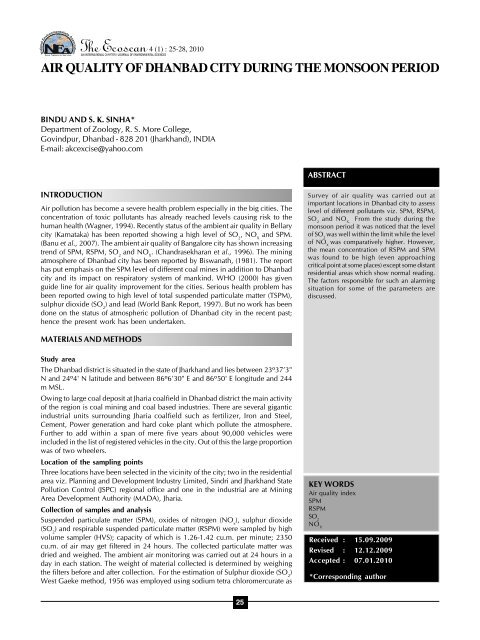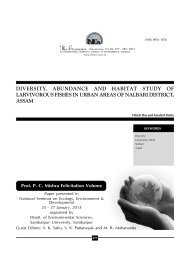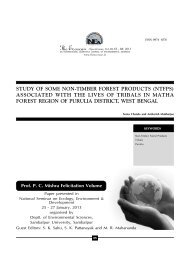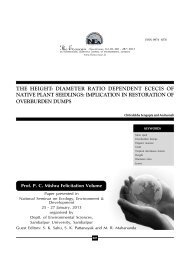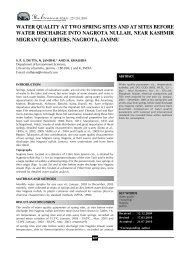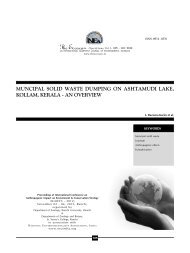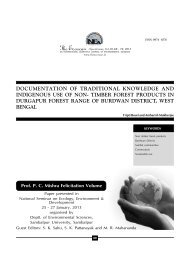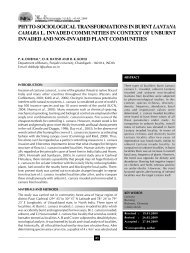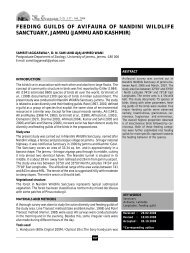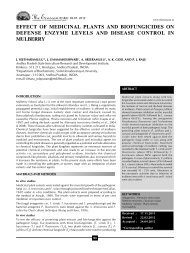full paper.pdf
full paper.pdf
full paper.pdf
Create successful ePaper yourself
Turn your PDF publications into a flip-book with our unique Google optimized e-Paper software.
NSave Nature to Survive<br />
QUARTERLY<br />
4 (1) : 25-28, 2010<br />
AIR QUALITY OF DHANBAD CITY DURING THE MONSOON PERIOD<br />
BINDU AND S. K. SINHA*<br />
Department of Zoology, R. S. More College,<br />
Govindpur, Dhanbad - 828 201 (Jharkhand), INDIA<br />
E-mail: akcexcise@yahoo.com<br />
ABSTRACT<br />
INTRODUCTION<br />
Air pollution has become a severe health problem especially in the big cities. The<br />
concentration of toxic pollutants has already reached levels causing risk to the<br />
human health (Wagner, 1994). Recently status of the ambient air quality in Bellary<br />
city (Karnataka) has been reported showing a high level of SO 2<br />
, NO X<br />
and SPM.<br />
(Banu et al., 2007). The ambient air quality of Bangalore city has shown increasing<br />
trend of SPM, RSPM, SO 2<br />
and NO X<br />
. (Chandrasekharan et al., 1996). The mining<br />
atmosphere of Dhanbad city has been reported by Biswanath, (1981). The report<br />
has put emphasis on the SPM level of different coal mines in addition to Dhanbad<br />
city and its impact on respiratory system of mankind. WHO (2000) has given<br />
guide line for air quality improvement for the cities. Serious health problem has<br />
been reported owing to high level of total suspended particulate matter (TSPM),<br />
sulphur dioxide (SO 2<br />
) and lead (World Bank Report, 1997). But no work has been<br />
done on the status of atmospheric pollution of Dhanbad city in the recent past;<br />
hence the present work has been undertaken.<br />
Survey of air quality was carried out at<br />
important locations in Dhanbad city to assess<br />
level of different pollutants viz. SPM, RSPM,<br />
SO 2<br />
and NO X.<br />
From the study during the<br />
monsoon period it was noticed that the level<br />
of SO 2<br />
was well within the limit while the level<br />
of NO X<br />
was comparatively higher. However,<br />
the mean concentration of RSPM and SPM<br />
was found to be high (even approaching<br />
critical point at some places) except some distant<br />
residential areas which show normal reading.<br />
The factors responsible for such an alarming<br />
situation for some of the parameters are<br />
discussed.<br />
MATERIALS AND METHODS<br />
Study area<br />
The Dhanbad district is situated in the state of Jharkhand and lies between 23º37’3"<br />
N and 24º4' N latitude and between 86º6’30" E and 86º50' E longitude and 244<br />
m MSL.<br />
Owing to large coal deposit at Jharia coalfield in Dhanbad district the main activity<br />
of the region is coal mining and coal based industries. There are several gigantic<br />
industrial units surrounding Jharia coalfield such as fertilizer, Iron and Steel,<br />
Cement, Power generation and hard coke plant which pollute the atmosphere.<br />
Further to add within a span of mere five years about 90,000 vehicles were<br />
included in the list of registered vehicles in the city. Out of this the large proportion<br />
was of two wheelers.<br />
Location of the sampling points<br />
Three locations have been selected in the vicinity of the city; two in the residential<br />
area viz. Planning and Development Industry Limited, Sindri and Jharkhand State<br />
Pollution Control (JSPC) regional office and one in the industrial are at Mining<br />
Area Development Authority (MADA), Jharia.<br />
Collection of samples and analysis<br />
Suspended particulate matter (SPM), oxides of nitrogen (NO x<br />
), sulphur dioxide<br />
(SO 2<br />
) and respirable suspended particulate matter (RSPM) were sampled by high<br />
volume sampler (HVS); capacity of which is 1.26-1.42 cu.m. per minute; 2350<br />
cu.m. of air may get filtered in 24 hours. The collected particulate matter was<br />
dried and weighed. The ambient air monitoring was carried out at 24 hours in a<br />
day in each station. The weight of material collected is determined by weighing<br />
the filters before and after collection. For the estimation of Sulphur dioxide (SO 2<br />
)<br />
West Gaeke method, 1956 was employed using sodium tetra chloromercurate as<br />
KEY WORDS<br />
Air quality index<br />
SPM<br />
RSPM<br />
SO 2<br />
NO X<br />
Received : 15.09.2009<br />
Revised : 12.12.2009<br />
Accepted : 07.01.2010<br />
*Corresponding author<br />
25
BINDU AND S. K. SINHA<br />
Table 1: Air - quality data monitored at different stations at Dhanbad during 2007<br />
Sampling SO 2<br />
NO 2<br />
RSPM SPM<br />
location Min Max M ± SD Min Max M ± SD Min Max M ± SD Min Max M ± SD<br />
J.S.P.C. 13.97 22.27 17.44±2.99 39.24 64.38 51.58±7.86 32.33 50.33 39.31±6.0 63 87.66 70.68 ±8.36<br />
MADA 11.14 17.63 15.21±1.80 26.83 53.16 43.26±8.84 50.66 165.33 110.13±31.17 98 206.66 154.90±30.54<br />
PDIL 12.40 21.18 14.93±2.82 36.66 49.04 42.18±3.44 45.33 118.33 83.3±23.16 83.66 156 115.50±24.71<br />
Values in μg/m 3<br />
Table 2: Air - quality data monitored at different stations at Dhanbad during 2008<br />
Sampling SO 2<br />
NO 2<br />
RSPM SPM<br />
location Min Max M±SD Min Max M ± SD Min Max M ± SD Min Max M ± SD<br />
J.S.P.C. 8.80 29.29 17.31±4.05 32.45 103.32 41.49 ± 9.3 39.56 161 87.42±27.84 65.56 229 137.09±40.02<br />
MADA 11.23 25.78 16.76±2.16 28.67 65.39 40.35±5.30 74.59 390 146.39±57.51 94.25 441 191.33±62.14<br />
PDIL 6.98 23.47 16.80±6.27 31.09 62.22 43.52±7.34 33.11 118 83.35±30.13 57.88 166 122.97±35.12<br />
Values in μg/m 3<br />
absorbent by spectrometric analysis and for the estimation of<br />
oxides of nitrogen (NOx) 0.1 N sodium hydroxide (NaOH)<br />
solution with 0.4 % of sodium arsenate was used as absorbing<br />
solution where it converts into nitrite ions. The nitrite content<br />
is again estimated spectrophotometrically by the method of<br />
IS: 5182 (Part-V).<br />
The values of different parameters are continuous in nature<br />
and one can take any value. In the current situation we need<br />
to define a particular normal probability distribution using<br />
only two parameters namely the mean (μ) and the standard<br />
deviation (δ).<br />
Normal Distribution is a continuous probability distribution<br />
that describes data that cluster around the mean. The graph of<br />
the associated probability density function is bell shaped, with<br />
a single peak at mean and known as the Gausian function or<br />
bell curve.<br />
The confidence interval for the normal distribution taken is<br />
95.45 % (μ-2δ
AIR QUALITY OF DHANBAD<br />
b. P (0
BINDU AND S. K. SINHA<br />
which is quite disturbing except RSPM and SPM which are<br />
leaping and requires urgent remedial measures.<br />
The present observation and the data were compared with<br />
the ambient air quality for India. It shows that the mean value<br />
of SPM level varies from 70.68 μg/m 3 to 115.5 μg/m 3 (moderate<br />
pollution level) in residential area in Dhanbad city while it is<br />
about 155 μg/m 3 (low pollution level) in industrial area. When<br />
compared with the National Annual Mean concentration it is<br />
found to be beyond low level (should be less than 70 μg/m 3 in<br />
residential area) and need immediate remedial measures while<br />
the same is within the minimum permissible limit (i.e. 152 μg/<br />
m 3 ) in industrial area (should be less than 180 μg/m 3 ). From<br />
the above data analysis it is pertinent to note that the pollution<br />
level in industrial area is not alarming to that extent because of<br />
increase in the number of dying industries but the situation in<br />
residential areas is showing alarming scenario in view of rise<br />
in automobile emission and human activity.<br />
When the maximum and minimum values of SPM for the two<br />
years are compared it is noticed that the same has a wide<br />
variation. While it was only 87.66 μg/m 3 in 2007 it raised to<br />
229 μg/m 3 in 2008 at the regional office of JSPC office. The<br />
same is true for PDIL, Sindri but marginally, which suffered a<br />
rise from 156 μg/m 3 to 166 μg/m 3 in the two monsoon seasons.<br />
It was found to be 206.66 μg/m 3 in 2007 raising to 441 μg/m 3<br />
in the month of 2008 at MADA, Jharia which moved from<br />
moderate to high level pollution in National level index. It is<br />
because of traffic congestion in the day time.<br />
In respect to RSPM level there is again wide variation noticed<br />
in the mean value of the two residential locations. It was only<br />
39.31 μg/m 3 in 2007 rising to 87.42 μg/m 3 in 2008 at JSPC<br />
regional office while it suffered no change at PDIL, Sindri (83<br />
μg/m 3 approx.). The maximum concentration level is again<br />
noticed in the busy hours to be about 50 μg/m 3 (rising to 161<br />
μg/m 3 in 2008) at the regional office while PDIL, Sindri again<br />
showed no variation at 118 μg/m 3 . In residential area it is<br />
already at the critical level in those particular hours i.e. more<br />
than 90 μg/m 3 and showing high level of pollution in industrial<br />
areas i.e. at 165.33 μg/m 3 .<br />
The mean value of SO 2<br />
is found to be well within the permissible<br />
limit both at residential areas as well as industrial areas ranging<br />
between 15- 17 μg/m 3 in both monsoon seasons when the<br />
normal limit is up to 40 μg/m 3 .<br />
However the mean value of the oxides of nitrogen (NO x<br />
) is<br />
moderate at residential area (JSPC regional office) i.e. 51.58<br />
μg/m 3 in 2007 which remained moderate in the second year,<br />
varying between 40 – 43 μg/m 3 .The situation is more or less<br />
similar at industrial area and noticed to be 43.26 μg/m 3 and<br />
40.35 μg/m 3 in two consecutive monsoon seasons at sampling<br />
location at MADA, Jharia.<br />
REFERENCES<br />
Banu, S. A., Zareena, Rajashekar, M. and Vijay Kumar, K., 2007. Status<br />
of Ambient Air Quality in Bellary city. The Bioscan. 3(2):143-145.<br />
Biswanath, S. 1981. Environmental pollution of mine atmosphere<br />
with special reference to particulate pollution, Ph.D. Thesis.<br />
Chandrasekharan , G. E., Ravichandran, C. and Shetty, N. 1996.<br />
Ambient Air Quality of selected sites in Bangalore city. IJEP. 17:184-<br />
188.<br />
Environmental Protection Agency (EPA) 1972. The Economics of<br />
Clean Air Congress, Annual Report to Congress, Washington, D. C.<br />
The World Bank and World Development Report. 1992. New York:<br />
Oxford University Press.<br />
Wagner, E.1994. Impact on air pollution in urban areas. J.<br />
Environmental Management. 18: 759-765.<br />
WHO 2000. Guide lines for air quality, World Health Organization,<br />
Geneva (http://www.who.int/peh/).<br />
28


